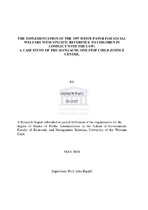| dc.description.abstract | Whilst policy formulation has been extensively studied and theorised in the literature, far less attention has been paid until fairly recently to the issue of policy implementation. For a long time it was more or less assumed that once policy was formulated, implementation was a relatively straightforward administrative matter. In the past twenty or thirty years, however, public administration scholars (such as Pressman and Wildavsky and, in the South African context, Brynard and de Coning) have devoted more attention to unravelling the complexities of policy implementation. The current study intends to apply these more theoretical approaches to an analysis of the implementation of the 1997 White Paper for Social Welfare with particular respect to children in conflict with the law, focusing specifically on the One Stop Child Justice Centre in Mangaung, Bloemfontein. Welfare Service in South Africa before 1994 had a racial bias with services mostly unavailable to the majority of the citizens of the country. The 1997 White Paper for Social Welfare, based on a developmental approach to social welfare, was designed to take the country in a new and inclusive direction. In line with South Africa’s 1996 ratification of the UN Convention on the Rights of the Child, as well as other international instruments, Section 4 of Chapter 8 of the White Paper focuses on crime prevention through development and restorative justice, and recommends diversion wherever possible in the case of juveniles. With respect to Juvenile justice, this section of the White Paper makes provision for the establishment of One Stop Child Justice Centres, where a variety of services, from Social Development, the Department of Justice, the South African Police Services, Correctional Services, and the NPA, would be available to clients under one roof. All of these role players, it was envisaged, would operate as a multi-disciplinary team to achieve the objectives of the White Paper with respect to developmental and restorative forms of justice. The Centre at Mangaung is one of only a few centres to have been established as yet in South Africa. Although focusing in particular on the implementation of the 1997 White Paper, the study is also informed by other policy and legislative measures with respect to juvenile justice, in particular the Child Justice Bill of 2002 (now the Child Justice Act of 2008) and the Probation Services Amendment Act of 2002. It is generally accepted by the Government and its critics alike that the policy scene in South Africa in the period since 1994 has been characterized by good policies but poor execution. This is, however, a relatively untested hypothesis and needs further investigation. In the light of this, it is anticipated, that the present study will make a contribution to the literature on policy implementation in South Africa, as well as providing useful insights and lessons that can inform general government policy in this regard, and policy with respect to juvenile justice in particular. Within the general context of the 1997 White Paper for Social Welfare and the Department of Social Development’s Integrated Service Delivery Model, and the specific context of the Mangaung One Stop Child Justice Centre, the overall purpose of the study is to scrutinize the apparent discontinuity between policy design on the one hand and policy implementation on the other. More specifically, though, the objectives of the study are: (i) to examine the content of the 1997 White Paper for Social Welfare in general and more specifically the section on children in conflict with the law, (ii) to provide a historical overview of the delivery of services to youth in conflict with the law prior to the first democratic elections (1994) in South Africa, (iii) to examine what the concept of ‘integrated service delivery’ means to the different role-players at the One Stop Child Justice Centre, (iv) to examine the existing resources (human, financial and other) for successful implementation of the policy,(v) to examine whether there are procedures in place to encourage co-operation among stakeholders at the One Stop Child Justice Centre, (vi) to examine the successes, challenges and opportunities presented by the implementation of this policy at the One Stop Child Justice Centre and, (vii) to identify gaps between policy and implementation and make recommendations towards more successful implementation. Detailed semi-structured interviews were conducted with the Centre Manager and senior representatives of all the services involved (Social Development, the SAPS, Magistrates, the Probation Service, and Prosecutors). The interview questions focus mainly on implementation issues and challenges, but also gather information on the knowledge of the interviewees on the content of the policy. In addition, in order to validate and compare the data collected from these respondents, semi-structured interviews were held with six parents/guardians of children in conflict with the law who had been serviced by the centre. Official documents of the centre, such as annual reports, were also consulted for purposes of triangulation. Detailed transcripts will be made of all the interviews. In analysing the data, use was made in particular of the 5C Protocol advocated by Brynard and De Coning (2006) in their study of policy implementation in South Africa. The five C’s include the Content of the policy, the Context in which the policy is implemented, Commitment from those implementing the policy, the role of Clients and Coalitions, and the Capacity of those tasked with implementing the policy. In addition other C’s which have an impact on policy implementation (such as communication, co-ordination, and change management) will also be considered. Confidentiality of data gathered and anonymity of respondents were ensured by not requiring any personal details from the survey instruments. The sole purpose of using the data gathered for research was communicated to the respondents on the front page of the survey instruments. The choice of also not answering questions raised was respected. | en_US |




